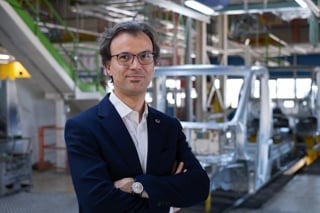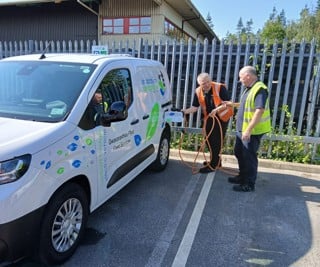This year’s Cenex Low-Carbon Vehicle (LCV) event, which took place September 10-11 at Millbrook Proving Ground, attracted more than 2,400 visitors and exhibitors – a 23% rise compared to LCV2013.
One of the highlights of the event was the launch of Mitsubishi’s first plug-in commercial 4X4 – the new Outlander GX3h 4Work (pictured), which follows the success of the plug-in Outlander passenger SUV earlier this year.
Priced at £23,373 (including the Government’s plug-in van grant and reclaiming the VAT), the Outlander GX3h 4 Work is designed for “tough commercial assignments”, according to Mitsubishi, with a “large and easily accessible rear payload space”.
It can travel 32.5 miles on battery power, emits 44g/km of CO2 and has an official combined fuel consumption figure of 148mpg, while super all-wheel control (S-AWC) delivers improved traction.
Mike Thomas, general manager of product planning for Mitsubishi, says: “The GX3h 4Work represents a significant cost reduction for companies running fleets of vans and independent businesses that need a reliable, all-conditions, all-weather workhorse.”
The LCV event also saw the launch of Cenex’s Fleet Carbon Reduction Tool (FCRT) Lite. The free online tool helps fleet decision-makers to assess the viability of low-carbon vehicles using real-world data.
Hydrogen gets Government backing
Hydrogen has a “part to play in the zero-emissions story” but at what point it becomes mass market is still up for debate, according to Emma Guthrie, hydrogen business manager at industrial gas company Air Products.
“The Government has committed to trying to push forward this technology to make good on its targets for air quality and emissions reduction,” she says. “Hydrogen is certainly seen as part of that story.”
However, she believes market development is still at a “very early stage”.
“We’re moving from technology demonstrations into early commercial roll-out,” she says.
The Hytec demonstration project has already seen a number of dual-fuel diesel hydrogen LCVs running in London and now the London Hydrogen Network Expansion (LHNE) project will provide an additional public hydrogen fuelling station in London, with hydrogen cars from Hyundai coming into operation.
Fleet operators also have the chance to get involved in a subsidised project, known as Hyfive, in which Hyundai and other automotive companies are taking part.
It aims to get more commercial deployment of cars, with up to 50 vehicles in operation as part of the trial.
“The idea is that ultimately you will be able to lease a hydrogen car under the same terms and conditions that you would expect for any other vehicle,” Guthrie says.
There is a strategic advantage to running a hydrogen vehicle now.
“Organisations that come into this early are seen as positive, early adopters,” says Guthrie. “You’re getting the experience before others.”
She also highlights the environmental benefits of operating a hydrogen vehicle and the operational advantages over a pure electric vehicle – a hydrogen vehicle can be charged in two to three minutes and can run 300-400 miles on one tank.
However, she points out that fleet operators will not be “tapping into a low-cost solution”.
“At the moment, we’re at demonstration phase so we’re not retailing in the same way in terms of fuel,” she says. “Our ultimate aim, and it has to be the case, is that fuel should be as comparable as possible.”
She also acknowledges that the number of fuelling stations is very small.
“What’s been positive is that the automotive industry is converging now around gaseous storage,” she says. “It means at the dispensing side you’re getting common dispensers, common fuelling protocols. That helps a lot in terms of standardising fuelling stations and bringing the supply chain to a more practical reality.”
Hydrogen fuelling stations pose as many risks as petroleum stations but the risks are different.
“You design the station to be safe in line with the type of fuel you have,” says Guthrie. “It’s part of our role as the industrial gas industry, which knows about the risks, to talk to stakeholders, such as fleet managers, and explain these and make people feel comfortable.”
Case study: University of Birmingham
The University of Birmingham has set a target of 40% of its fleet of 98 vehicles being fully electric or hydrogen fuel cell vehicles by 2020.
Currently, 15% of its fleet is hydrogen fuel cell, electric or hybrid.
“Most of our vehicles do 4,000-5,000 miles a year around campus and we have got four charging points so 40% of our fleet is quite achievable in the long-term,” says Monica Guise, post, portering and transport manager at the University of Birmingham.
The university has been running electric and hydrogen vehicles for the past four years and has its own hydrogen fuelling station on site, which is managed by the School of Chemical Engineering.
Guise says there were air quality and environmental reasons for adopting electric and hydrogen vehicles but one of the biggest reasons was the Government’s decision to link the university’s funding to its carbon management plan back in 2011.
“We have a strong argument to our staff to say ‘we’re not only saving the environment, we’re saving jobs on campus too’,” says Guise.
A change in leasing companies’ attitude to residual values on electric vehicles over the past year has also been a “big driver” for the university.
“In the past it has been quite difficult for companies to invest a considerable amount of money in electric vehicles,” explains Guise.
“Now, it’s £1,000 extra a year for us to lease an electric vehicle compared to a combustion engine vehicle.
“If you work out the fuel cost its levels itself out. You can suddenly make it work for you.”
Case study: Fruit 4 London
Without electric vehicles we would no longer be in business, says Laszlo Mulato, co-founder of Fruit 4 London.
The company, which delivers fresh fruit to offices in central London, has been running Renault Kangoo ZEs since 2012, with anticipated savings of £16,500 per vehicle over three years, compared to a diesel Ford Transit.
The bulk of the savings come from the London congestion charge as Fruit 4 London’s vans enter the zone every day and the Kangoo ZE qualifies for a 100% discount.
Fruit 4 London is also saving on fuel (the Kangoo ZE costs £215 over 12,000 miles compared to £2,618 in the Ford Transit) and CO2 (the Kangoo ZE generates 1.5 tonnes of CO2 over 12,000 miles compared to 5.6 tonnes).
“We would like to install solar panels into our warehouse so we can start generating our own electricity and cut another 1.5 tonnes of CO2,” says Mulato.
The electric vehicles do 40 to 60 miles a day and operate between 5am and 11am, which means there is enough time to recharge them and get them prepared for the next day.
“Electric vehicles have proven to be perfect for this job,” Mulato says. “Every single person that has started driving for us loves it because there is no vibration, the vehicles are quiet and they can focus on the road. They are easy to drive and they are powerful.”
Fruit 4 London is also saving £700-£800 per vehicle on maintenance as brake pads and discs do not need changing.
However, there have been compromises.
The Kangoo ZE is a lot smaller than the Ford Transit and Fruit 4 London has had to redesign the boxes in which it stores fruit to fit the cargo space.
It has also found that the Kangoo ZE’s range drops during the winter months due to power needed for heating.
However, the vehicles can be programmed to pre-heat before they are driven.
“The driving style is more important than using the heater or not,” Mulato says. “You have to be forward-thinking when you drive. If you see a red light there is no point pushing the gas. Let the car roll and save energy, then you can use the heating a bit longer. I would lose about 10 miles by using the heating – from 80 miles it would drop to 70 miles – but that still fits into the range we need to do.”
In the future, Fruit 4 London hopes to introduce an evening delivery service for private clients.
“We could recharge the vans in the afternoon and then they will be out again making money for us,” says Mulato.


















Login to comment
Comments
No comments have been made yet.